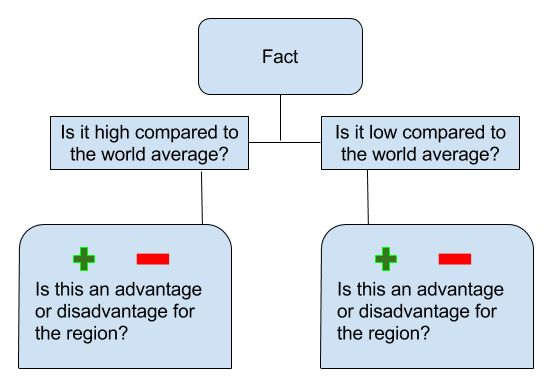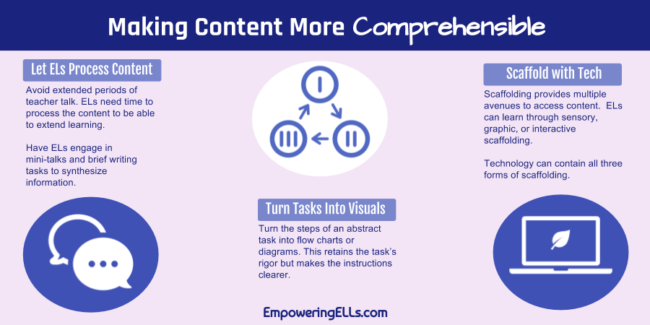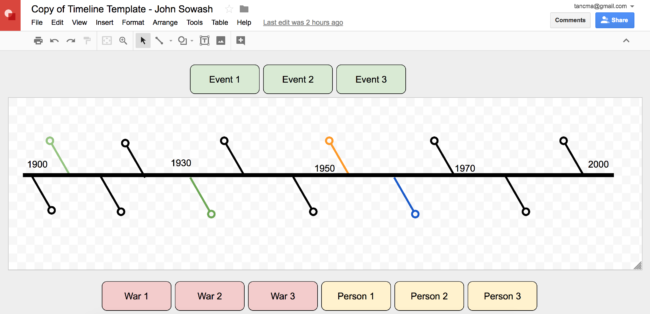When I first moved to Laos to teach, I didn’t understand any Lao, so people resorted to pointing and gesturing to help me comprehend their ideas. The kind ladies in the market didn’t expect me to go back to the U.S. to learn Lao at a proficient level before communicating. They met me where I was… And they wanted to help.
Likewise, we have to meet our ELs where they are in their language development. We can do this by employing specific strategies that establish comprehensible input. This article, therefore, is about making instruction more understandable for ELs by focusing on comprehensible input. It forms Part 3 of the Sheltered Instruction series.
In Making Content Comprehensible for English Learners: The SIOP Model (5th Edition) (SIOP Series), Echevarria, Vogt, and Short recommend the following strategies to make content comprehensible:
- speech appropriate for students’ proficiency levels
- clear explanations of academic tasks and
- a variety of techniques used to make content concepts clear (28).
Speech appropriate for students’ proficiency levels
There are so many things that I can tackle this first recommendation: vocabulary, speech, body language, and more. However, more important than how teachers speak to ELs is how long they speak.
Teachers often talk more than students can process the information. Some teachers see instruction as delivering content, but they should really think about teaching as facilitating understanding.
Imagine a pizza pie. When it’s delivered, it comes pre-sliced into small pieces because it’s unpleasant and impossible to shove an entire pizza pie down our throats. Likewise, we have to deliver content in pre-sliced portions to enable ELs to talk about content in a manageable way.

Pixabay.com
A simple way to chunk content is to invite students to talk to each other about it. I chunk information by dividing it into:
- important details,
- significant events, or
- complex concepts.
There are numerous discussion structures that pedagogy guru Jennifer Gonzales recommends, but the easiest ones I recommend are:
These are low-prep structures that let ELs pause anywhere from 1-3 minutes to process what they’ve learned. Regardless of the structure you use, we must shift from talking at ELs to inviting discussion about content.
Clear expectations of academic tasks
Academic tasks are meant to be challenging, but when compounded with learning a new language, they can make ELs feel like Sisyphus eternally rolling his heavy boulder uphill only to watch it come crashing back down again. We want to stretch, not snap our students. It’s actually quite simple to make academic tasks more comprehensible to ELs: use images.
We often think of using images to communicate vocabulary words or an event. But images can also represent a series of steps required of a complex task. For example, when I was co-planning with Ms. Lauren and Mr. Lucas (two 8th grade history teachers), they explained an activity they designed to help students think about some statistics related to using resources.
As they described the steps, I realized that even though I’m a native English user, I was still confused To help me and the students understand, I converted the steps into the flowchart below. The flowchart visually guides students through the initially complex process. It didn’t lower the rigor of the task; it simply made the expectations clearer.
Later, after the lesson, Ms. Lauren said that she noticed how much the flowchart was helping all of her students, not just the ELs. This was another good reminder that when we co-plan, it’s more about who’s receiving ELs services than who’s labeled as an EL.
We typically help ELs in first developing social language and then move to mastering academic language. However, students who are born to an English-speaking family already have established social language skills, so we need to focus on fostering academic language proficiency. But, as teachers of language acquisition, we can offer our support to non-ELs as well when they too need to understand and use academic language.

A variety of techniques used to make content concepts clear
One overarching technique to make content clearer is scaffolding, which is the process of using various techniques develop understanding of a concept. Scaffolding is particularly important for when teaching ELs. When a concept is particularly abstract and complex, we use different ways to scaffold their understanding. The more scaffolding provided, the more bridges to understanding.
An earlier article I wrote on the various forms of scaffolding describes the use of:
- sensory scaffolds (ie: models, manipulatives, visuals)
- interactive scaffolds (ie: discussions, partner work, dramatizations) and
- graphic scaffolds (ie: tables, charts, timelines, infographics)
Comprehensible Input with Technology
We should also consider the use of technology to establish comprehensible input as it can contain elements of sensory, interactive, and graphic scaffolding. Our students are born into an age that expects them to be digital natives, and integrating technology not only increases their familiarity with it, it also encourages interaction with the content.
For example, John Sowash created this timeline in Google Drawing to improve his students’ comprehensible input of historical events. There are boxes for events, wars and people involved that students were to move around to the correct location.
Sowash’s timeline contains visuals, encourages students to learn through interactions, and the content is presented graphically – all elements of scaffolding.
Engaging with content by using scaffolds or technology shifts passive learning into active learning. For ELs, the more active the learning, the more they’re able to retain. When we make content clearer, it really means designing lessons that invite ELs to engage, think, and create. Regardless of the tech you use, I still encourage incorporating technology in the classroom to prompt active learning and to establish comprehensible input.
[Side note] Sowash and I were part of Tony Vincent’s Class Graphics course, which I highly recommend tech-oriented teachers enroll in.
Takeaways
When teaching ELs, we need to focus on what they can do instead of what they can’t do yet. Likewise, we have to look in the mirror and focus on what we can do to establish comprehensible input. Making content comprehensible is not about lowering our expectations for ELs. It’s about using specific techniques to maintain high expectations for students.
With these three strategies, educators can make challenging academic content comprehensible. And, in doing so, uphold the promise to provide every student with the same high quality education they deserve.
Nora, Julie, and Jana Echevarria. No More Low Expectations for English Learners. Heinemann, 2016.



